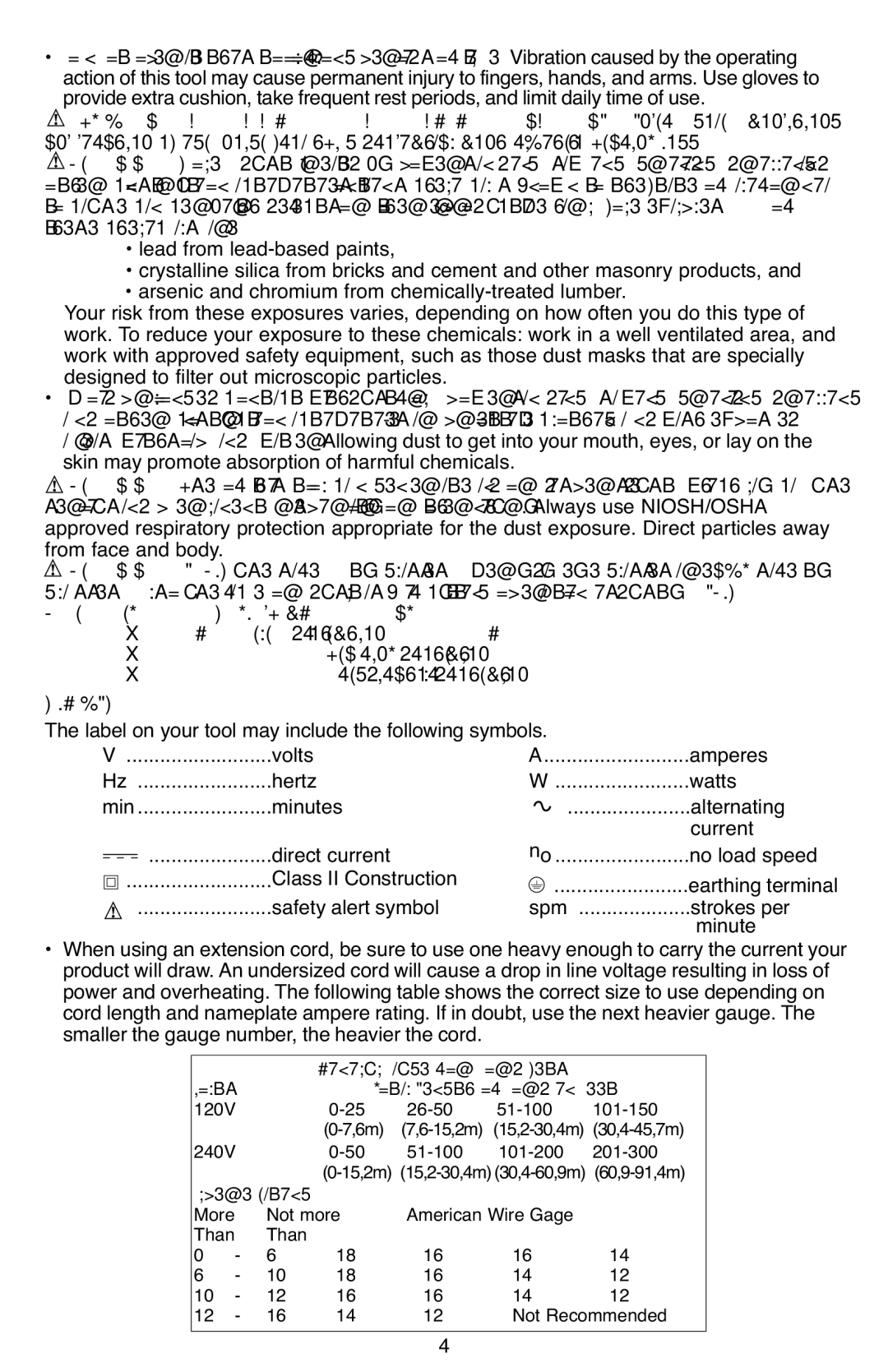
•Vibration caused by the operating
actionDo notofoperatethistoolthismaytoolcauseforpermanentlong p riodsinjuryof timeto fingers,. hands,and arms. Use gloves to provide extra cushion, take frequent rest periods, and limit daily time ofuse.
Wear appropriate hearing protection during use. Under some conditions
andCAUTION:duration of use, noise from this product may contribute to hearing loss.
![]() WARNING: Some dust created by power sanding, sawing, grinding, drilling, and
WARNING: Some dust created by power sanding, sawing, grinding, drilling, and
other construction activities contains chemicals known to the State of California | ||||||||||||||
to cause cancer, birth defects or other reproductive harm. Some examples of | ||||||||||||||
| • lead from |
|
|
|
|
|
|
| ||||||
these chemicals are: |
|
|
|
|
|
|
|
|
|
| ||||
| • crystalline silica from bricks and cement and other masonry products, and | |||||||||||||
| • arsenic and chromium from | |||||||||||||
Your risk from these exposures varies, depending on how often you do this type of | ||||||||||||||
work. To reduce your exposure to these chemicals: work in a well ventilated area, and | ||||||||||||||
work with approved safety equipment, such as those dust masks that are specially | ||||||||||||||
designed to filter out microscopic particles. |
|
|
|
|
|
| ||||||||
• Avoid prolonged contact with dust from power sanding, sawing, grinding, drilling, | ||||||||||||||
areas with soap and wa er.Allowing dust to get into your mouth, eyes, or lay on the | ||||||||||||||
and other construction activities. Wear prot ctive clothing and wash exp sed | ||||||||||||||
skin may promote absorption of harmful chemicals. |
|
|
| |||||||||||
serious and ermanent respir | tory or othe injury. Always use NIOSH/OSHA | |||||||||||||
WARNING: Use of this tool can generate and/or disperse dust, which may cause | ||||||||||||||
approved respiratory protection appropriate for the dust exposure. Direct particles away | ||||||||||||||
from face and body. |
|
|
|
|
|
|
|
|
|
|
| |||
WARNING: ALWAYS use safety glasses. Everyda y eye glasses are NOT safety | ||||||||||||||
glasses. A lso use face or dust mask if cutting operation is dusty. ALWAYS | ||||||||||||||
| • ANSI Z87.1 eye protection (CAN/CSA Z94.3) |
|
|
| ||||||||||
WEAR CERTIF ED SAFETY EQUIPMENT: |
|
|
|
|
|
| ||||||||
| • ANSI S12.6 (S3.19) hearing protection |
|
|
|
|
|
| |||||||
| • NIOSH/OSHA/MSHA respiratory protection |
|
|
| ||||||||||
SYMBOLS |
|
|
|
|
|
|
|
|
|
|
| |||
The label on your tool may include the following symbols | amperes | |||||||||||||
V | volts |
|
|
| A | |||||||||
Hz | hertz |
|
|
| W | watts | ||||||||
min | minutes |
|
|
|
| ...................... | alternating | |||||||
|
|
|
|
|
|
|
|
| no | current | ||||
|
| ...................... |
|
| direct current |
| no load speed | |||||||
|
|
|
|
|
| |||||||||
| .......................... |
|
| Class II Construction |
|
| ........................ | earthing terminal | ||||||
|
|
|
|
| spm | |||||||||
| ........................ |
|
| safety alert symbol | strokes per | |||||||||
|
|
|
|
|
|
|
|
|
|
|
| minute | ||
• When using an extension cord, be sure to use one heavy enough to carry the current your | ||||||||||||||
product will draw. An undersized cord will cause a drop in line voltage resultingin loss of | ||||||||||||||
power and overheating. The following table shows the correct size to usedepending on | ||||||||||||||
cord length and nameplate ampere rating. If in doubt, use the next heaviergauge. The | ||||||||||||||
smaller the gauge number, the heavier the cord. |
|
|
|
|
|
| ||||||||
|
|
| 120V | Minimum Gauge for Cord Sets |
|
| ||||||||
|
|
|
|
|
| |||||||||
|
|
| Volts |
|
| Total Length of Cord in Feet |
|
| ||||||
|
|
| 240V |
|
| |||||||||
|
|
|
|
|
| |||||||||
|
|
| Ampere Ra |
|
| |||||||||
|
|
| More |
| Not more |
| American Wire Gage |
|
|
| ||||
|
|
| Than | - | Than | 18 |
| 16 | 16 |
| 14 |
|
| |
|
|
| 0 | 6 |
|
|
|
| ||||||
|
|
| 6 | - | 10 | 18 |
| 16 | 14 |
| 12 |
|
| |
|
|
| 10 | - | 12 | 16 |
| 16 | 14 |
| 12 |
|
| |
|
|
| 12 | - | 16 | 14 |
| 124 | Not Recommended |
|
| |||
|
|
|
|
|
| |||||||||
